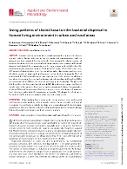| dc.contributor.author | Grönroos, M | |
| dc.contributor.author | Jumpponen, A | |
| dc.contributor.author | Roslund, M I | |
| dc.contributor.author | Nurminen, N | |
| dc.contributor.author | Oikarinen, S | |
| dc.contributor.author | Parajuli, A | |
| dc.contributor.author | Laitinen, O H | |
| dc.contributor.author | Cinek, Ondřej | |
| dc.contributor.author | Kramná, Lenka | |
| dc.contributor.author | Rajaniemi, J | |
| dc.contributor.author | Hyöty, H | |
| dc.contributor.author | Puhakka, R | |
| dc.contributor.author | Sinkkonen, A | |
| dc.date.accessioned | 2024-09-22T10:15:19Z | |
| dc.date.available | 2024-09-22T10:15:19Z | |
| dc.date.issued | 2024 | |
| dc.identifier.uri | https://hdl.handle.net/20.500.14178/2619 | |
| dc.description.abstract | Contact with environmental microbial communities primes the human immune system. Factors determining the distribution of microorganisms, such as dispersal, are thus important for human health. Here, we used the relative number of bacteria shared between environmental and human samples as a measure of bacterial dispersal and studied these associations with living environment and lifestyles. We analyzed amplicon sequence variants (ASVs) of the V4 region of 16S rDNA gene from 347 samples of doormat dust as well as samples of saliva, skin swabs, and feces from 53 elderly people in urban and rural areas in Finland at three timepoints. We first enumerated the ASVs shared between doormat and one of the human sample types (i.e., saliva, skin swab, or feces) of each individual subject and calculated the shared ASVs as a proportion of all ASVs in the given sample type of that individual. We observed that the patterns for the proportions of shared ASVs differed among seasons and human sample type. In skin samples, there was a negative association between the proportion of shared ASVs and the coverage of built environment (a proxy for degree of urbanization), whereas in saliva data, this association was positive. We discuss these findings in the context of differing species pools in urban and rural environments. IMPORTANCE: Understanding how environmental microorganisms reach and interact with humans is a key question when aiming to increase human contacts with natural microbiota. Few methods are suitable for studying microbial dispersal at relatively large spatial scales. Thus, we tested an indirect method and studied patterns of bacterial taxa that are shared between humans and their living environment. | en |
| dc.language.iso | en | |
| dc.relation.url | https://doi.org/10.1128/aem.00903-24 | |
| dc.rights | Creative Commons Uveďte původ 4.0 International | cs |
| dc.rights | Creative Commons Attribution 4.0 International | en |
| dc.title | Using patterns of shared taxa to infer bacterial dispersal in human living environment in urban and rural areas | en |
| dcterms.accessRights | openAccess | |
| dcterms.license | https://creativecommons.org/licenses/by/4.0/legalcode | |
| dc.date.updated | 2025-01-15T10:11:11Z | |
| dc.subject.keyword | bacteria | en |
| dc.subject.keyword | biodiversity hypothesis | en |
| dc.subject.keyword | dispersal | en |
| dc.subject.keyword | hygiene hypothesis | en |
| dc.subject.keyword | land cover | en |
| dc.identifier.eissn | 1098-5336 | |
| dc.relation.fundingReference | info:eu-repo/grantAgreement/MSM//LX22NPO5103 | |
| dc.relation.fundingReference | info:eu-repo/grantAgreement/EU/FP8/874864 | |
| dc.relation.fundingReference | info:eu-repo/grantAgreement/EU/FP8/874864 | |
| dc.date.embargoStartDate | 2025-01-15 | |
| dc.type.obd | 73 | |
| dc.type.version | info:eu-repo/semantics/publishedVersion | |
| dc.identifier.doi | 10.1128/aem.00903-24 | |
| dc.identifier.utWos | 001304198400001 | |
| dc.identifier.eidScopus | 2-s2.0-85207600456 | |
| dc.identifier.obd | 651809 | |
| dc.identifier.pubmed | 39230286 | |
| dc.subject.rivPrimary | 30000::30300::30303 | |
| dcterms.isPartOf.name | Applied and Environmental Microbiology | |
| dcterms.isPartOf.issn | 0099-2240 | |
| dcterms.isPartOf.journalYear | 2024 | |
| dcterms.isPartOf.journalVolume | 90 | |
| dcterms.isPartOf.journalIssue | 10 | |
| uk.faculty.primaryId | 109 | |
| uk.faculty.primaryName | 2. lékařská fakulta | cs |
| uk.faculty.primaryName | Second Faculty of Medicine | en |
| uk.faculty.secondaryId | 52 | |
| uk.faculty.secondaryName | Fakultní nemocnice v Motole | cs |
| uk.faculty.secondaryName | Motol University Hospital | en |
| uk.department.primaryId | 109 | |
| uk.department.primaryName | 2. lékařská fakulta | cs |
| uk.department.primaryName | Second Faculty of Medicine | en |
| uk.department.secondaryId | 1701 | |
| uk.department.secondaryId | 100010693902 | |
| uk.department.secondaryName | Ústav lékařské mikrobiologie | cs |
| uk.department.secondaryName | Ústav lékařské mikrobiologie | en |
| uk.department.secondaryName | Ústav lékařské mikrobiologie 2. LF UK a FN Motol | cs |
| uk.department.secondaryName | Department of Medical Microbiology, 2nd Faculty of Medicine and Motol University Hospital | en |
| dc.type.obdHierarchyCs | ČLÁNEK V ČASOPISU::článek v časopisu::původní článek | cs |
| dc.type.obdHierarchyEn | JOURNAL ARTICLE::journal article::original article | en |
| dc.type.obdHierarchyCode | 73::152::206 | en |
| uk.displayTitle | Using patterns of shared taxa to infer bacterial dispersal in human living environment in urban and rural areas | en |

